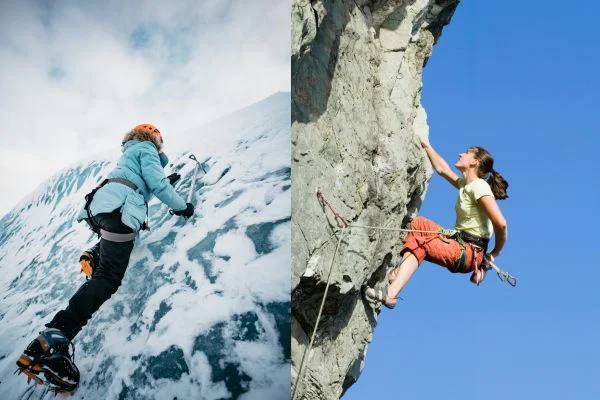Whether you’re a seasoned climber or just starting, you’ve probably asked yourself, “is ice climbing harder than rock climbing?”. After all, both activities require strength and skill. But what are the differences between them? Let’s take a closer look at how these two activities differ and how you can decide which is right for you.
Is Ice Climbing Harder Than Rock Climbing | Comparison
The Gear
Regarding gear, ice climbing and rock climbing are different. Ice climbers often use technical tools like crampons, ice axes, and spiked boots to gain purchase on the slippery surface of an icy cliff. On the other hand, rock climbers typically rely on their hands and feet to grip small holds in the rock face.
While there is some overlap between the gear used for both sports (such as harnesses and carabiners), each activity requires a unique set of specialized tools.
The Skillset
In addition to a different gear, ice climbing also requires a different skill set from rock climbing. Ice climbers must be able to read icy faces to determine where they can safely place their tools without damaging them or risking injury from falling chunks of ice.
They also need to accurately judge when an ice axe placement is secure enough for them to continue ascending or descending a route.
On the other hand, rock climbers must be able to identify small holds that can support their weight while navigating obstacles on a route. Both activities require problem-solving skills and physical endurance to complete the climb successfully.
Also Read: What Do You Need For Ice Climbing?
The Experience Level
Finally, it’s essential to consider your experience level when deciding which activity is suitable for you. For example, ice climbing tends to be more dangerous than rock climbing since there are fewer places where you can securely place your tools and because icy surfaces can break away unexpectedly under your feet or hands.
Therefore, if you’re starting with either sport, it may be best, to begin with, rock climbing until you feel confident in your ability and judgment before attempting an icy ascent or descent.
However, if you have prior experience with either activity, choosing between them becomes less about safety considerations and personal preference — so don’t be afraid to try something new!
Also Read: Does Rock Climbing Help You Lose Weight?
What Are The Four Levels Of Climbing Difficulty?

Climbing routes are typically classified into one of four categories according to their difficulty. Although some routes may cross over between categories, here is a basic breakdown of each level:
Beginner Level (V0-V2)
Beginner climbs are rated V0 through V2 on the Yosemite Decimal System (YDS) scale, designed specifically for climbers new to the sport. Since these climbs involve mostly basic moves with few technical challenges, they usually consist of relatively easy routes that allow climbers to become familiar with the fundamentals.
As a bonus, more experienced climbers will often find beginner routes helpful in warming up before attempting more challenging climbs.
Intermediate Level (V3-V5)
Intermediate climbs range from V3 to V5 on the YDS scale, and they typically involve slightly more complicated moves than beginner routes. This level entails more complex maneuvers such as stemming, laybacking, mantling, side pulling, and crimping—all of which require a good technique to complete successfully.
Also known as “vertical terrain” or “above vertical terrain,” this level is ideal for climbers who have some experience but aren’t ready for advanced routes yet.
Advanced Level (V6-V9)
Advanced climbs are rated anywhere from V6 through V9 on the YDS scale. They usually incorporate very challenging maneuvers, such as dynamic moves and powerful sequences that require a lot of strength and precision to complete them successfully.
As a result, these climbs should only be attempted by experienced climbers who have already mastered all the basics. Otherwise, they could put themselves in danger due to their lack of knowledge or skill.
Expert Level (V10+)
Expert climbs are rated V10 or higher on the YDS scale, requiring extreme strength, power, endurance, balance, flexibility, coordination—and, most importantly—experience to complete them successfully.
Due to their extreme difficulty level, these climbs should only be attempted by seasoned professionals who have already mastered all lower levels of difficulty first—otherwise, they could potentially endanger themselves due to their lack of knowledge or skill level.
Also Read: Is Ice Climbing Dangerous?
Conclusion:
At the end of the day, the answer to the question is ice climbing harder than rock climbing comes down to personal preference and experience level. Ice climbers must have different skills from those required by rock climbers and special access equipment, such as crampons and ice axes, to perform safely on icy surfaces.
For those who are just starting with either sport, it may be best, to begin with, rock climbing before attempting an icy ascent or descent — however, experienced climbers should feel free to try out whichever activity appeals most!
Remember that safety should always come first, no matter which type of climb you choose, remember that safety should always come first!



